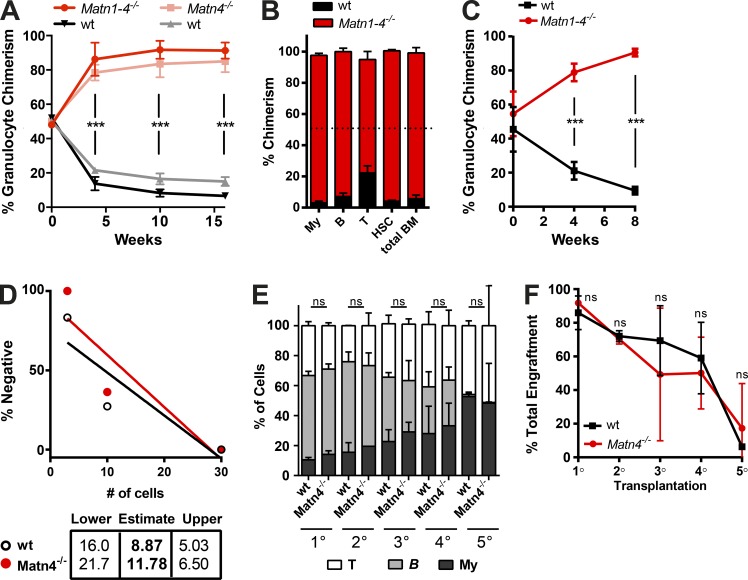Figure 4.
Matn4-deficient HSCs show improved long-term repopulation capacity. (A) Blood granulocyte (Gr1+CD11b+) chimerism of WT CD45.1/Matn4−/− or WT CD45.1/Matn1–4−/− 50:50 chimeras, determined 0, 4, 10, and 16 wk after transplant. (B) BM chimerism of myeloid (CD11b+Gr-1+), B (B220+), and T cells (CD4+CD8+), HSCs (LSKCD150+CD48−), and whole BM of WT CD45.1/Matn1–4−/− 50:50 chimeras 16 wk after transplant. B, B cells; My, myeloid; T, T cells. (C) Blood granulocyte (Gr1+CD11b+) chimerism of secondary WT CD45.1/Matn1–4−/− 50:50 chimeras, determined 0, 4, 8, and 20 wk after transplant. (A–C) n = 6 mice/group. Unpaired Student’s t test analysis was performed on three independent experiments. ***, P < 0.001. Data are mean ± SD. (D) 3, 10, or 30 sorted WT CD45.1/2 and Matn-4−/− LT-HSCs (LSKCD150+CD48−) were transplanted into lethally irradiated recipients, and engraftment was checked at 8 and 12 wk. The number of HSCs was determined using the ELDA software. Two independent experiments and 3–6 mice/group are shown. (E) Serial transplantations of 100% BM of four individual WT littermate or Matn4−/− mice, retransplanted every ≥16 wk into new lethally irradiated recipients. Blood chimerism was analyzed 12–14 wk after transplant. (F) Percent engraftment of WT littermate or Matn4−/− BM cells harvested from quaternary chimeras 16 wk after transplant. (E and F) n = 4 mice/group. Unpaired Student’s t test analysis was performed on four biological replicates. ***, P < 0.001. Data are mean ± SEM.

